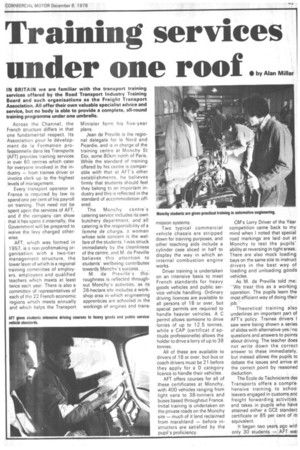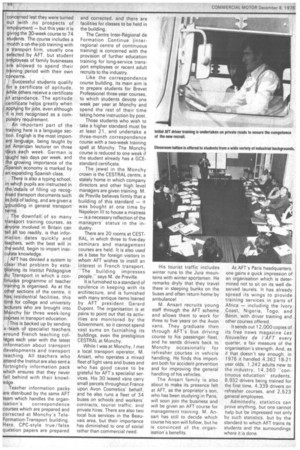Training services under one roof
Page 45

Page 46

If you've noticed an error in this article please click here to report it so we can fix it.
IN BRITAIN we are familiar with the transport training services offered by the Road Transport Industry Training Board and such organisations as the Freight Transport Association. All offer their own valuable specialist advice and service, but no body is able to provide a complete, all-round training programme under one umbrella.
Across the Channel, the French structure differs in that one fundamental respect. Its Association pour le development de la Formation professionnelle dans les Transports (AFT) provides training services in over 60 centres which cater for everyone involved in the industry — from trainee driver or invoice clerk up to the highest levels of management.
Every transport operator in France is required by law to spend one per cent of his payroll on training. That need not be spent upon the services of AFT, and if the company can show that it has spent it internally, the Government will be prepared to waive the levy charged otherwise.
AFT, which was formed in 1957, is a non-profitmaking organisation with a two-tier management structure, the lower layer of which is a regional training committee of employers, employees and qualified teachers which meets at least twice each year. There is also a committee of representatives of each of the 22 French economic regions which meets annually and which helps the Transport Minister form his five-year plans.
Jean de Preville is the regional delegate for le Nord and Picardie, and is in charge of the training centre at Monchy St Eloi, some 80km north of Paris, While the standard of training offered by his centre is comparable with that at AFT's other establishments, he believes firmly that students should feel they belong to an important industry and this is reflected in the standard of accommodation offered.
The Monchy centre's catering service includes its own butchery department, and all catering is the responsibility of a femme de charge, a woman whose sole concern is the welfare of the students. I was struck immediately by the cleanliness of the centre, and M. de Preville believes this attention to students' wellbeing contributes towards _MonchYs success. M. de Preville's thoroughness is reflected throughout Monchy's activIties, as its 26-hectare site includes a workshop area in which engineering apprentices are schooled in the workings of engines and trans
mission systems.
Two typical commercial vehicle chassis are stripped down for training purposes, and other teaching aids include a cylinder case sliced in half to display the way in which an internal combustion engine works.
Driver training is undertaken on an intensive basis to meet French standards for heavy goods vehicles and public service vehicle handling. Ordinary driving licences are available to all persons of 18 or over, but special permits are required to handle heavier vehicles. A C permit allows someone to drive lorries of up to 12.5 tonnes, while a CAP (certificat d'aptitude professionelle) allows the holder to drive a lorry of up to 38 tonnes.
All of these are available to drivers of 18 or over, but bus or coach drivers must be 21 before they apply for a D category licence to handle their vehicles.
AFT offers courses for all of these certificates at Monchy, with 400 vehicles ranging from light vans to 38-tonners and buses based throughout France. Initial training is undertaken on the private roads on the Monchy site — much of it land reclaimed from marshland — before instructors are satisfied by the pupil's proficiency.
CM's Lorry Driver of the Year competition came back to my
mind when I noted that special road markings are laid out at Monchy to test the pupils' ability at reversing in tight areas.
There are also mock loading bays on the same site to instruct drivers in the best way of loading and unloading goods vehicles.
As M. de Preville told me: "We treat this as a working
operation. The pupils learn the most efficient way of doing their job."
Theoretical training also underlines an important part of AFT's policy. Trainee drivers I saw were being shown a series of slides with alternative yes/no questions and answers to points about driving. The teacher does not write down the correct answer to these immediately, but instead allows the pupils to debate the issues and arrive at the correct .point by reasoned deduction.
The Ecole de Techniciens des Transports offers a comprehensive training to schoo leavers engaged in customs anc freight forwarding activities, and takes in pupils who have attained either a GCE standarc certificate or 85 per cent of it equivalent.
It began two years ago witt only 30 students — AFT we!
concerned lest they were turned out with no prospects of employment — but this year it is giving the 30-week course to 74 students. The course includes a month's on-the-job training with a transport firm, usually one selected by AFT, but student employees of family businesses are allowed to spend their training period with their own concerns.
, Successful students qualify . for a certificate of aptitude, while others receive a certificate of attendance. The aptitude ;certificate helps greatly when applying for jobs, even although it is not recognised as a compulsory requirement.
An important part of the training here is a language section. English is the most important language, being taught by an American lecturer on three days each week. German is taught two days per week, and the growing importance of the Spanish economy is marked by an expanding Spanish class.
There is also a typing school, in which pupils are instructed in the details of filling up recognised transport documents such as bills of lading, and are given a !grounding in general transport terms.
The downfall of so many transport training courses, as anyone involved in Britain can tell all too readily, is that information dates quickly and teachers, with the best will in the world, begin to impart inaccurate knowledge.
• AFT has devised a system to clear that problem by establishing its Institut Peclagogiue du Transport in which a continuous programme of teacher training is organised. As at the other sections of the centre, it has residential facilities, this time for college and university lecturers who are brought into Monchy for three week-long courses in transport education.
This is backed up by sending a ,team of specialist teachers around French teaching colleges each year with the latest information about transport developments and transport teaching. All teachers who attend the Institut are also sent a fortnightly information pack which ensures that they never fall behind with their knowledge.
Teacher information packs are distribued by the same AFT team which handles the organ isation's correspondence courses which are prepared and corrected at Monchy's TeleFormation-Transport building. Here, CPC-style true/false question papers are prepared and corrected, and there are facilities for classes to be held in the building.
The Centre Inter-Regional de Formation Continue (interregional centre of continuous training) is concerned with the provision of further education training for long-service transport employees or recent adult recruits to the industry.
Like the correspondence course building, its main aim is to prepare students for Brevet Professionel three-year courses, to which students devo,te one week per year at Monchy and spend the rest of their time taking home instruction by post.
Those students who wish to take a higher standard must be at least 21, and undertake a three-month correspondence course with a two-week training spell at Monchy. The Monchy course is reduced to one week if the student already has a GCEstandard certificate.
The jewel in the Monchy crown is the CESTRAL centre, a stately home in which company directors and other high level managers are given training. M. de Preville believes firmly that a building of this standard — it was bought at one time by Napoleon III to house a mistress — is a necessary reflection of the managers status in the industry.
There are 20 rooms at CESTRAL, in which three to five-day seminars and management courses are held. It is also used as a base for foreign visitors in whom AFT wishes to instill an interest in French transport. "The building impresses people,says M. de Preville.
It is furnished to a standard of opulence in keeping with its architecture, and is furnished with many antique items loaned by AFT president Gerard Dupont. The organisation is at pains to point out that its activities are monitored by the Government, so it cannot spend vast sums on furnishing its buildings, even the prestigious CESTRAL at Monchy.
While I was at Monchy, I met a local transport operator, M. Ansart, who operates a mixed fleet of tight vans and buses and who has good cause to be grateful for AFT's specialist ser vices. His 30 leased vans carry small parcels throughout France upon Avon Cosmetics' behalf, and he also runs a fleet of 34 buses on schools and workers' contracts, tourist traffic, and private hires. There are also two local bus services in the Beau vais area, but their importance has diminished to one of social rather than commercial need.
His tourist traffic includes winter runs to the Jura mountains with winter sportsmen. He remarks dryly that they travel there in sleeping bunks on the buses and often return home by ambulance!
M. Ansart recruits young staff through the AFT scheme and allows them to work for three to five years on the Avon vans. They graduate then through AFT's bus driving course to his passenger fleet, and he sends drivers back to Monchy occasionally for refresher courses in vehicle handling. He finds this important both for accident prevention and for improving the general handling of his vehicles.
The Ansart family is also about to make its presence felt at AFT, as the proprietor's son, who has been studying in Paris, will soon join the business and will be given an AFT course for management training. M. Ansart has still to decide which course his son will follow, but he is convinced of the organisation's benefits.
At AFT's Paris headquarters, one gains a quick impression of an organisation which is determined not to sit on its well -deserved laurels. It has already spread its wings to provide training services. in parts of Africa — including the Ivory Coast, Nigeria, Togo, and Benin, with driver training and other courses offered.
It sends out 12,000 copies of its free news magazine Les Nouvelles de l'AFT every quarter, a fair measure of the organisation's strength. And, as if that doesn't say enough, in 1976 it handled 4,362 18-21 year olds, 1,242 adults new to the industry, 14,360 "continuous education" students, 8,932 drivers being trained for the first time, 4,339 drivers on refresher courses, and 2,523 general employees.
Admittedly, statistics can prove anything, but one cannot help but be impressed not only by such statistics, but by the standard to which AFT trains its students and the surroundings where it is done.
































































































































